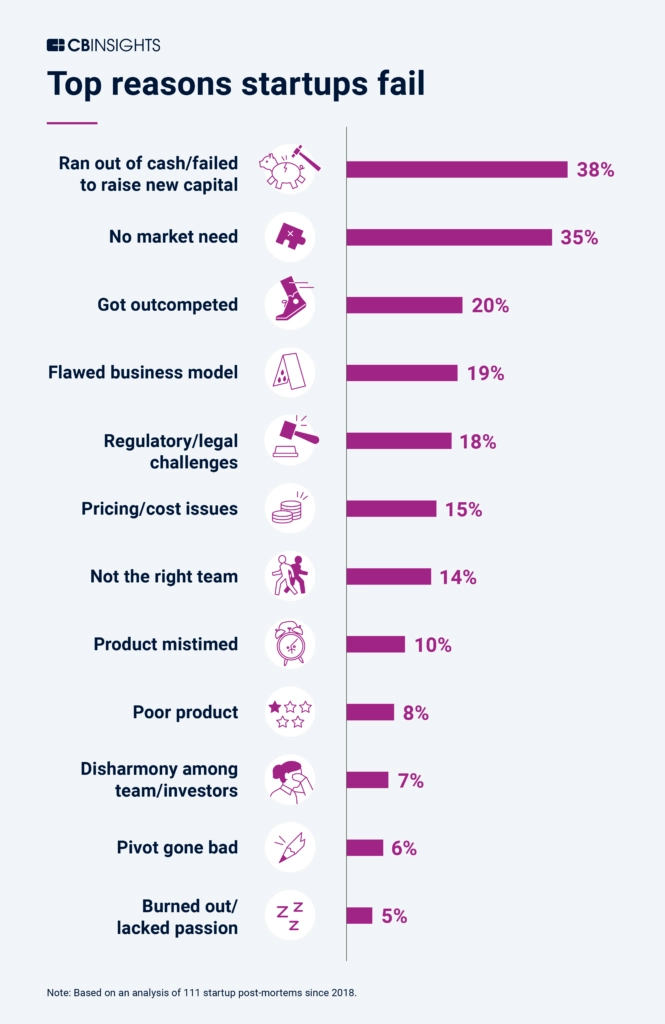

Startup failure: what can be learned from it?
What are the success factors for an innovative business? Founders ask that a lot, especially in the custom software development field, as the tech startups comprise a majority of ventures. But they fail more often than they don't.
Startup founders often focus on the process of product building instead of the market need. They spend too much or develop too slow. 34% of them fail during the first 12 months, and 42% fail to identify the market demand and solve the problem at all. Some stories about entrepreneurial failure are about unresolved conflicts and critical misses while others are about finding a new opportunity in shutdown.
This article tells two of such stories: about a telemedicine venture, Call9, and the famous communication tool Slack and offers lessons from failed startups.
Case study: Call9. Why has development stopped?
The telemedicine project entitled Call9 was considered one of the most promising startups of 2019. Its primary idea was to offer active technology use in nursing homes. Call9 offered senior people a comfortable way to speak with a doctor in case of an emergency without having to dial 911.
The New-York-based startup originated in 2015. Founder, Dr. Tim Peck, decided to establish on-demand doctors services for elderly patients who suffered moral and physical distress because they needed to visit hospitals way too often. The idea of providing round-the-clock support from first responders into care homes sounded both needed and innovative. They would connect the elderly to a doctor through Call9, and there would be no need for unnecessary visits.
At a glance, the startup possessed all the necessary resources to create a successful enterprise with high demand in 2020. The environment of the global pandemic would be perfect for Call9's, but ironically, when the time came it was too late. Having raised over $34 million throughout its history, the company ran out of cash, was required to lay off up to 100 employees in 2019, and shut down. So, what exactly went wrong?
There is no primary reason for Call9’s failure, but a combination of factors played their role.
Initially, the payment scheme and transportation logistics did not work. The “value cared basis” was being adopted in the United States too slow, so doctors have been hesitant to participate in a project with a vague payment. (In the value-based model, doctors aren’t paid a fixed price for a consultation; they’re paid for patient outcomes.)
Obviously, to find reach and customers, Call9 relied on partnerships within the healthcare organizations — care homes. These partners — care homes — were not fast technology adopters, and the revenue stream couldn't gain pace.
Then, Call9 made a deal with Lyft, a partnership to schedule rides for patients’ family members by the emergency staff via Lyft’s Concierge platform. Lyft wanted to decrease the number of missed and unused appointments in the US; to deepen its healthcare footprint. Yet, for Call9, it was an extra option introduced too early for the market. The contract with Lyft required more costs than it could bring new customers.
Their marketing has been throughout as well, with attracting celebrities like Ashton Kutcher but monetary problems with the startup made investors decide the project couldn't efficiently deliver. This is a classic case for healthcare ventures. "Move fast and break things" doesn't exactly work in this industry, yet investors continue to hope someone would make it so. Even with 142,000 successfully treated patients, Call9 failed and had to be closed.

Case Study: Slack. How failure turns to success
Everyone knows the corporate team messaging tool called Slack. After going to IPO in 2019, the company’s value was estimated at over $23 billion, Reuters reports. Who could think that the initial project of the team was a catastrophe?
Stewart Butterfield’s team was working on a social MMORPG — massive online role-play called Glitch. In 2009, the Canadian company Tiny Speck (that will be Slack Technologies Inc. later) raised $1.5 million in angel funding to start their software development project. They worked from 2009 to 2011, and in 2011 Glitch was released. Founders withdrew it, though; they weren't satisfied with the quality of the game. The project was closed.
They built internal software for communication between their American and Canadian offices. That will be soon called Slack.
The startup did not realize its degree of success until receiving about $180 million in funding in 2014 and another $360 million in 2015-2016 to improve and market the messenger. The company became the 2016 top cloud app according to Forbes.
Slack is so good because developers built it for themselves. The creative spirit and wit of the game development company allowed them to scale it quickly and efficiently. The team was a right fit even before they went to market. They are now one of the most popular communication tools and almost everyone in their audience knows about Slack. Fewer people remember Tiny Speck, though, but it was a failure that led to success—as many failures actually do.
How entrepreneurs can learn from failure? According to Butterfield, they had to shut Glitch down because it was too "foreign." It was the only non-combat MMO on the market, and few gamers actually understood its humor and the fun in its gameplay. The team rushed to deadlines. Glitch has Flash as a base technology. They failed, and Slack rushed to the victory, right into a product-market fit, with the right audience in mind and a lean product pipeline. Cool? Cool.
Recognize opportunity in failure. It’s better to test your product and fail fast, so you could see the issues you had from a different perspective and try again.
So, what business failure lessons can be learned from startup cases discussed above?
First of all, do not expect your fresh idea to immediately win. Find investors who share your values and are experienced or at least familiars with the quirks of your industry. Use funds carefully.
Ensure that your proof of concept addresses the market need effectively and is not designed just to serve your ambitions or assumptions on what the audience would want.
Maybe there's a pivot hidden in your failure, like in Slack's case. Don't focus on the fact you've failed. Add it to your experience and gain strength from it. There is no other way to build a startup and not to fail except for going there and trying to.
Tell us about your project
Fill out the form or contact us

Tell us about your project
Thank you
Your submission is received and we will contact you soon
Follow us
